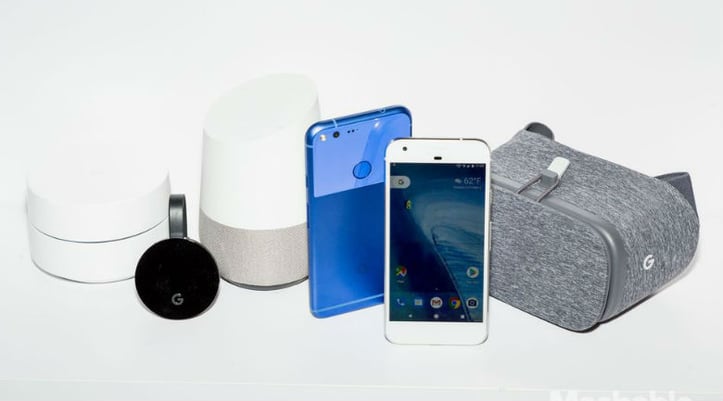Mila Hose | Oct 6, 2016 12:58:36 PM
4 Min Read

Google announced some exciting hardware releases at its #MadeByGoogle event this week, and at these products’ core is software that is increasingly focused on machine learning and artificial intelligence. Recently, Google has made strides at becoming an AI-first organization and immersing virtual reality into users’ daily lives; marketers should take note of Google's movement in order to begin fully leveraging their location data today.
Artificial Intelligence
Consumers expect answers to their questions and accurate, locally-relevant results from their mobile devices and personal assistants. CEO Sundar Pichai predicted that the world will move from being mobile-first to AI-first in the near future. Google is acutely aware of the need for a personalized user experience, which is why the goal is to “build a personal Google for each and every user.” Because of this, the Google Assistant is at the heart of its new products.
With Google Home and Pixel, Google’s new smartphone, users will be able to make “near me” searches from the comfort of their couch and have directions sent to their phone. Instead of scrolling to find more results, users will complete their search with the first three options that the Google Assistant provides from the local 3 pack. As the dependency on personal assistants for local answers increases, brands need to ensure that their local pages are claimed on all platforms, that NAP data is accurate and updated and that relevant categories are claimed. As users continue to take a more conversational approach to queries made via personal assistants, it will be critical to optimize for longtail keywords and maintain a local-social presence for each location.
Machine Learning
An AI-first era is dependent on machine learning, the ability for personal assistants to make predictive suggestions and habitual results. Google has already improved machine learning in the past several years, unlocking the ability to understand minute differences in images and to translate language from a low-accuracy, phrase-by-phrase level, to a highly accurate sentence-by-sentence level that closely models human speech. Most importantly, however, Google’s text-to-speech recognition permits the Google Assistant to reach human-level accuracy in its responses. Its goal is to one day be able to both understand human emotion and respond with parallel emotions when interacting with a user.
Why should this matter to enterprise level marketers? Imagine a scenario in which a user does not remember the name of your restaurant or store, but wants to return. They need only ask their personal assistant for directions to “that restaurant with [specific menu item]” or "that one store with the red bullseye logo” for the personal assistant to quickly match those specific attributes to your business and lead the user to the nearest location. Brands can benefit from machine learning by ensuring that that each store location has a unique image associated with it and that categories, products, menu items and services are keyword-optimized and as accurate and descriptive as possible.
Virtual Reality
Augmented and virtual reality are already leading adoption of the AI era, which we recently saw with Pokemon Go . Google is making VR/AR technology more friendly and accessible for the everyday user. “We believe that [virtual reality] is not just a technology,” said Clay Bavor, VP of Virtual Reality at Google, “it’s something that is going to be important because of it's transportive experience.”
With the belief that AR and VR will ultimately change the way people explore, work, learn and play, Google’s Daydream technology will make AR/VR accessible from the touch of a user’s phone. Google View is Google’s Daydream-ready headset that will be necessary to unlock the VR/AR features, at which point users can be transported to over 150 real-world places in 70 different countries to explore the world from the point of view of a variety of perspectives, including a Pharaoh’s Island sheep.
As virtual reality and augmented reality become an everyday part of a user’s life, this technology will transform the ways in which enterprise brands can interact with consumers and customize their brand-specific gamification and loyalty programs.
It all comes down to data. Brands need to have a centralized location content management system that can house and update their location data and product inventory and track the preferences of local consumers who are interacting with the world of AR and VR around them. With AR/VR technology still in the early stages, your brand has the potential to leverage location data today and build creative new experiences to keep it ahead for tomorrow.
Artificial-intelligence-first software will continue to bridge the gap between the online to offline experience, and location data will be essential to building this bridge. Set your brand up for success in the AI first era by auditing your location data performance today with Brandify’s Quick Scan.
Topics: Virtual Reality, Augmented Reality
Content writer @ Brandify.
Offer Post Justifications Spotted in Local Results
Oct 4, 2021 8:47:46 AM
Monday Memo: More than Brands and Influencers, Consumers Trust Each Other
Sep 27, 2021 7:56:34 AM
Monday Memo: Google Adds “Latino-Owned” to GMB Identity Attributes
Sep 20, 2021 7:58:58 AM
Monday Memo: New Study Shows 94% of Consumers Use Online Business Directories
Sep 13, 2021 7:16:55 AM
Monday Memo: The Page Experience Update Has Fully Rolled Out
Sep 6, 2021 7:43:45 AM